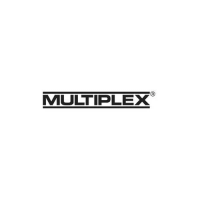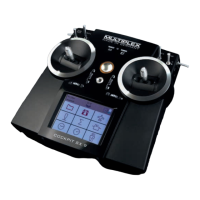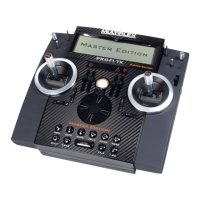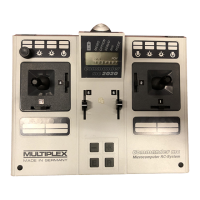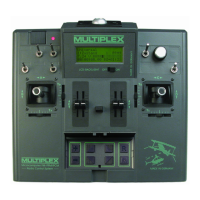Instructions
Page 81
accordance with this default set-up. If your model fea-
tures a different type of swashplate control system, you
will need to alter these values to suit.
The control travels can now be adjusted in the menu H
Control (è 14.2.4. Aileron Trvl, Pitch axis Trvl)
Step ’’ Setting up the collective pitch curve
The collective pitch curve is set up in the menu H Con-
trol Collect. (è 14.2.9.).
A separate collective pitch curve can be set for each
flight phase, so that the collective pitch control system
is an optimum match to each flight phase. For example:
• Hover
Collective pitch range -2 ... +10°: this means that the
model is less sensitive in response at collective
pitch minimum, making it easier to land the heli-
copter under full control.
• Acro
Collective pitch range -10 ... +10°: this means that
the model behaves the same in upright and in-
verted flight.
• Autorot
Collective pitch range -8 ... +12°: this means that the
optimum rotor blade settings for auto-rotation are
available at collective pitch minimum and maxi-
mum.
' TIP:
The blade pitch angle for hovering is usually in the
range approx. 4 ... 5°. When you are adjusting the collec-
tive pitch curves it is important to ensure that this value
is achieved at roughly the same position of the collec-
tive pitch stick on all the collective pitch curves you set
up, otherwise the model will “jump” when you switch
from one flight phase to another.
!! Note: Models with CCPM swashplate
The collective pitch curve points P1 and P6 should not
be set to + or - 100%, as this would mean that symmet-
rical cyclic control movements (pitch-axis or roll) would
not be possible at collective pitch maximum and collec-
tive pitch minimum. Depending on the set travels for
roll and pitch-axis we recommend a maximum setting
of approx. 75 ... 80% for P1 and P6.
Step ““ Setting up the throttle curve
The throttle curve is set up in the menu H Control,
Throttle (è 14.2.10).
The purpose of setting up a throttle curve is to obtain
constant system rotational speed over the full range of
collective pitch. Stable flight handling can only be
achieved if this is the case. Fine-tuning can only be car-
ried out during actual test-flying.
!! Note
The throttle limiter must be at the full-throttle position,
and the direct throttle switch must be set to OFF. In this
situation the collective pitch -> throttle mixer is acti-
vated, and the throttle servo follows the movement of
the collective pitch stick in the ratio dictated by the
throttle curve you have set.
Step ”” Setting up the tail rotor mixer
(static tail rotor compensation / REVO-MIX)
The tail rotor mixer is set up in the menu G Mixer, TAIL
(è 15.4).
In the model templates HELImech and HELIccpm tail
rotor compensation is switched off by default. If your
model is fitted with a modern gyro system which is
always operated in Heading Lock mode, you must set all
values for the TAIL mixer to OFF or 0%. An alternative is
to control the tail rotor directly using the Yaw function
instead of the TAIL mixer. To do this you need to change
the servo assignment (K menu, Servo/Assignment ->
16.2.) from TAIL to Yaw
If you are using a gyro system which is required to work
in normal or damping mode, the TAIL mixer should be
activated and set up carefully. This mixer prevents the
characteristic swing of the model around its vertical axis
when the torque level changes, and makes it easier for
the gyro to achieve optimum tail stabilisation.
This is the procedure for setting up tail rotor compensa-
tion:
1. Ensure that the servo output arm and the tail rotor
actuating arm are at right-angles to the tail rotor
pushrod when the tail rotor servo is at the neutral
position. If necessary adjust the length of the tail ro-
tor pushrod until this is the case. An accurate me-
chanical adjustment in this way automatically de-
fines a pre-set tail rotor setting which minimises the
helicopter’s tendency to swing when hovering.
' TIP:
If you fold both tail rotor blades to one side, the dis-
tance between the blade tips should be around 10 -
20 mm; the actual figure varies with the model.
2. Now move the collective pitch stick to the hover
position. You can now set the correct starting point
for the tail rotor compensation mixer by transfer-
ring the value of the Collective pitch parameter to
the Zero point parameter.
3. The level of tail rotor compensation for climb can
now be adjusted using the parameter Collective
pitch max. “Coll.+”.
Move the collective pitch stick to the Climb position
(collective pitch maximum), and set an initial value
which doubles the distance between the tail rotor
blade tips (when folded together as previously de-
scribed). Now move the collective pitch stick to the
Descend position (collective pitch minimum) and
set an initial value which reduces the distance be-
tween the tail rotor blade tips almost to 0 (approx. 5
mm).
For the other flight phases (apart from Auto-rotation) it
is safe to start by adopting the same values. Fine ad-
justment of tail rotor compensation (Collective pitch+,
Collective pitch-) for the various flight phases can only
be carried out during flight-testing.
In the flight phase Autorotation (AUTOROT) tail rotor
compensation is not needed, as the motor is switched
off or at idle in this phase, and produces no torque
which requires compensation. For this phase set a value
of OFF for the parameters Collective pitch+ and Collec-
tive pitch-. Set the Offset parameter to a value which
sets the blade tips of the (folded) tail rotor blades in a
line (= blade pitch angle 0°).
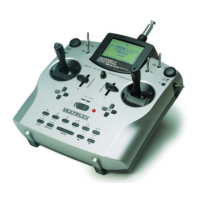
